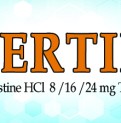VERTIN
Betahistine is an antivertigo drug first used for treating vertigo associated with Meniere’s disease. It is also commonly used for patients with balance disorders.
- Categories : Anti-Vertigo
- Share Now :
VERTIN 8/16
Generic Name: Betahistine HCl
Therapeutic Category: Anti-vertigo
Pharmacological Class: Histamine
Composition: Vertin 8
Each film coated tablet contains Betahistine HCl USP 8 mg
Vertin 16
Each film coated tablet contains Betahistine HCl USP 16 mg
Pregnancy Category: B
Presentation: Available in the pack size as 10 tablets X 10 strips
Mechanism of Action
Betahistine predominantly interacts with histaminergic receptors. Betahistine has a very strong affinity as an antagonist for histamine H3 receptors and a weak affinity as an agonist for histamine H1 receptors.
- H1 receptor agonist would give rise to local vasodilation and increased permeability. which helps to reverse the underlying problem of endolymphatic hydrops. Betahistine seems to dilate the blood vessels within the inner ear which can relieve pressure from excess fluid.
- Betahistine blocks H3 receptors and releases neurotransmitters (histamine, norepinephrine, Ach, GABA). The increased amounts of histamine released from histaminergic nerve endings can stimulate histamine receptors. This stimulation explains the potent vasodilatory effects of betahistine in the inner ear.
Indications
- Meniere’s Disease (Vertigo, Dizziness, Tinnitus)
- Central Vestibular Disorder
- Cochlear disease
Dosage
Route of administration: Oral
- Initially, 8-16 mg 3 times daily (TID), preferably with food.
- Maintenance dose 24-48 mg daily
- For acute attacks, treatments include 8-16mg up to TDS
- Preventive measures for recurrent attacks include:
16mg regularly TDS seems most effective in Meniere’s disease
Not recommended for children
Pharmacokinetics
Absorption: Rapidly absorbed from the gastrointestinal tract.
Protein binding: Very low
Metabolism: Hepatic
Route of elimination: Renal
Half-life: 3.5 hours
Adverse Effects
- Headache
- Low level of gastric side effects
- Nausea can be a side effect, but the patient is generally already experiencing nausea due to the vertigo so it goes largely unnoticed.
- Patients taking Vertin may experience several hypersensitivity and allergic reactions
Contraindications
VERTIN is contraindicated in the following populations and situations:
- Hypersensitivity to betahistine or any component of the formulation
- Pheochromocytoma*
- Peptic Ulcer Disease
Precautions
- People with Bronchial asthma.
Drug Interactions
- Enhance hypotensive effect of Tamsulosin when given with antihypertensive drugs (e.g. ACE inhibitors, B-Blockers, Calcium channel blocker etc.), adrenergic neuron blocker, alcohol, alpha blockers, Angiotensin-II receptor antagonist, antipsychotic, anxiolytic and hypnotic drugs.
*Terminologies:
Pheochromocytoma: A tumor of the adrenal glands.


